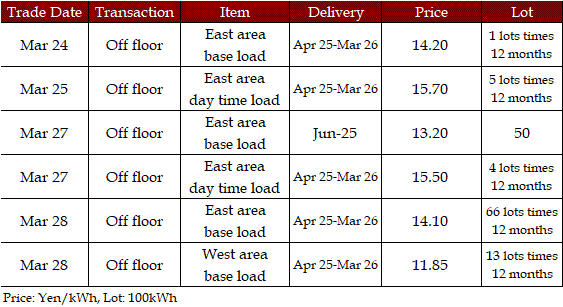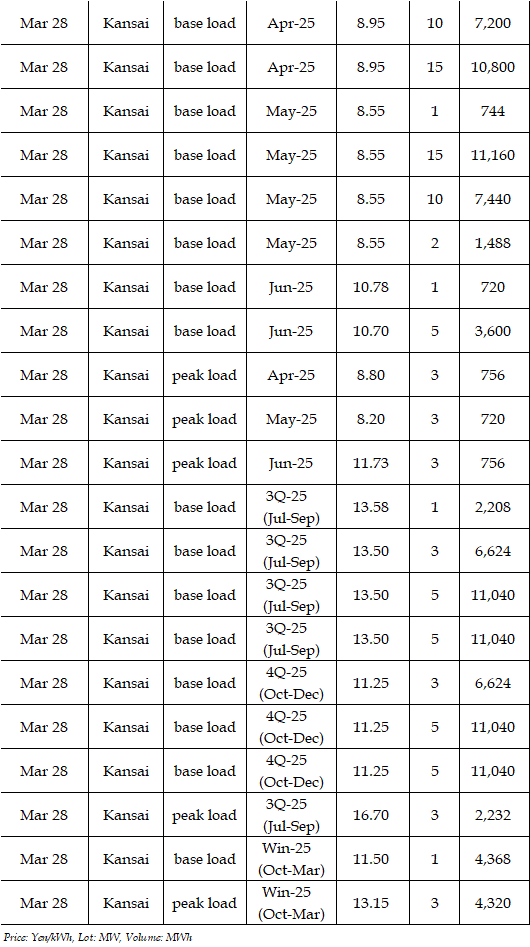|
In the day-ahead market on JEPX (Japan Electric Power Exchange), the 24-hour spot power prices on a weekly average basis for Mar 24-28 delivery plummeted from the previous week in both East Japan (50Hz) and West Japan (60Hz). An arrival of typical spring climate loosened up supply-demand fundamentals. The temperatures exceeded 25 degrees broadly in Kanto and further west, and even reached 30 degrees at Takada in Joetsu city in Niigata prefecture on Mar 27. It was the first time to mark 30 degrees in the mainland of Japan in March. In addition, solar power supply was ample mostly during the week, pushing down spot prices to Yen 0.01 across Japan even on weekdays.
In Shikoku, the Honshu-Shikoku Interconnection Line connecting Chugoku and Shikoku suspended operation since night time on Mar 23 for safety reasons following a series of wildfires that occurred in Okayama city and Imabari city in Ehime prefecture. As a result, power supply generated in Shikoku lost outlets in the mainland, creating a serious overhang within in Shikoku and ending up pushing down spot prices to Yen 0.01 throughout 48 windows during 00:00-24:00 hours for Mar 25 delivery. The abnormal phenomenon with a flood of Yen 0.01 throughout the day was repeated for Mar 26 delivery. From Mar 27 delivery onward, Shikoku marked Yen 3.00 and Yen 5.00 in some windows, but still stuck to Yen 0.01 in most time Zones. The Honshu-Shikoku Interconnection Line will remain out of service through Mar 31, Shikoku is believed to sink to extreme lows through the end of this month.
In Tokyo and Kansai, the key areas in East Japan and West Japan, the 24-hour average posted a difference in favor of the East by Yen 2.99 for Mar 24 delivery, Yen 0.66 for Mar 25 delivery, Yen 2.44 for Mar 26 delivery, Yen 3.04 for Mar 27 delivery and Yen 0.46 for Mar 28 delivery.
The fuel market trends in the fourth week of March were detailed as follows.
DES Northeast Asia spot LNG prices stood in the low $13 per mmBtu for prompt May 2025 arrival as of Mar 27, softening by more than 50cts from the end of the previous week (Mar 21). A weakness in European natural gas prices pushed down the LNG market in Northeast Asia. Besides that, LNG prices were also pressured by growing availability combined with slim buying interest in Northeast Asia. The Ministry of Economy, Trade and Industry (METI) announced on Mar 26 that Japan's LNG inventories for power generation stood at 1.83 mil mt as of Mar 23, up 170,000mt from a week before. The figure was up from 1.48 mil mt as of end-March last year, but down from the average of past five years at 2.03 mil mt.
FOB Newcastle thermal coal prices in Australia stood in the high $96 level per ton for March 2025 loading as of Mar 27. The level was down about 20cts from the end of the previous week, reflecting a fall in gas prices.
In the crude oil market, WTI crude for April 2025 stood around $70 per barrel as of the morning on Mar 28 while Brent crude for May 2025 was trading around $74. Compared with the end of the previous week, WTI strengthened by slightly less than 3 while Brent was up slightly less than $2. Crude futures were bolstered by the projection that the US tariff policy would slash crude oil supply from Venezuela. A drawdown in US crude oil inventories also lent support to the crude oil market. Still, upside room in crude prices was limited amid unabated concerns that US Trump administration's trade policy could trigger a slowdown in the global economy and a slump in crude oil demand. President Trump announced on Mar 26 that he would introduce fresh tariffs on imports of automobiles and essential parts to US.
The actual highest price during the week was at Yen 18.77 in Hokkaido for Mar 24 delivery. Meanwhile, the actual lowest price during the week was at Yen 0.01 in all of nine areas and the System Price (SP) for Mar 25 delivery, eight areas except Hokkaido and SP for Mar 26 delivery, and Shikoku for Mar 27-28 delivery.
By area, the weekly average of the 24-hour spot prices was at Yen 10.00 in Hokkaido, down Yen 4.37 from the previous week, Yen 9.55 in Tohoku, down Yen 3.67, Yen 9.76 in Tokyo, down Yen 3.60, Yen 8.65 in Chubu, down Yen 4.91, Yen 7.84 in Hokuriku and Kansai, down Yen 5.75, Yen 7.82 in Chugoku, down Yen 5.35, Yen 2.10 in Shikoku, down Yen 10.45, and Yen 7.46 in Kyushu, down Yen 3.65.
In the JEPX auction, volumes of offers were 1,405.23 mil kWh on a weekly average basis, up 13.9% from the previous week. Meanwhile, bids on a weekly average basis dwindled by 17.0% to 867.74 mil kWh. The weekly average of trade volumes shrank by 6.6% to 763.78 mil kWh.
Power demand in nine areas of Japan during Mar 24-28 was a combined 10,519.36 mil kWh, down 16.8% from 12,648.14 mil kWh during Mar 17-21. The figure was down 11.9% from the corresponding period a year earlier. Demand during Mar 25-29, 2024 after day of week adjustment was 11,837.90 mil kWh.
Deals reported on TOCOM (Tokyo Commodity Exchange) during Mar 24-28 were as below.

Deals reported on EEX (European Energy Exchange) during Mar 24-28 were as below.







In the first week of April, or the kickoff of the new fiscal year, spot prices are likely to chase upside in the first half of the week. The temperatures will drop sharply from the fourth week of March with early-summer climate. The highest temperature will be capped around 15 degrees in West Japan and even fall below 15 degrees in Kanto. Thus, heating demand could be renewed in East Japan and spot prices may accelerate a rally. But the temperatures are forecast to track an upward trend from the middle of the week onward, and spot prices will likely head south in line with milder climate. A source at a power producer and supplier said, "In East Japan, the 24-hour average has a chance to rise near Yen 15 in the first half of the week. In West Japan, the 24-hour average will be capped around Yen 10 at highest. In this sense, the East-West price gap is likely to widen." With an increasing number of thermal units off line for regular maintenance, there is a chance of unexpected price hikes in case of a sudden change in temperatures or unplanned facility troubles. Meanwhile, bilateral OTC contracts will be renewed at the turn of the fiscal year, so that any change in hedging proportions with bilateral OTC deals could affect the trend of spot prices.
|
JEPX: System Price (Day Ahead 24 hours)
|
|
Weekday Price
|
24-Mar
|
25-Mar
|
26-Mar
|
27-Mar
|
28-Mar
|
|
24-Hour Ave
|
10.46
|
6.20
|
6.54
|
8.95
|
8.36
|
|
Volume (MWh)
|
748,529
|
787,649
|
789,583
|
759,343
|
733,805
|
|
(unit: yen per kWh) (date: delivery day)
|
|
|

|